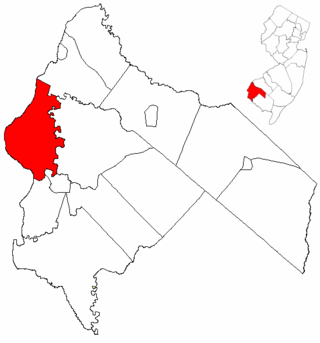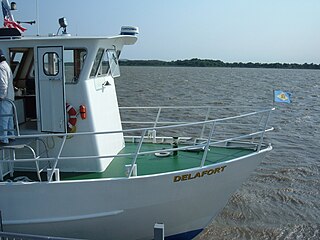
New Sweden was a colony of the Swedish Empire along the lower reaches of the Delaware River between 1638 and 1655 in present-day Delaware, Maryland, New Jersey, and Pennsylvania in the United States. Established during the Thirty Years' War when Sweden was a great power, New Sweden formed part of the Swedish efforts to colonize the Americas.

Pennsville Township is a township in Salem County, in the U.S. state of New Jersey. The township is named for William Penn. The township includes the state's westernmost point. As of the 2020 United States census, the township's population was 12,684, a decrease of 725 (−5.4%) from the 2010 census count of 13,409, which in turn reflected an increase of 215 (+1.6%) from the 13,194 counted in the 2000 census.

Salem is a city in Salem County, in the U.S. state of New Jersey. It is the county seat of Salem County, the state's most rural county. The name Salem, for both the city and county, is derived from the Hebrew word shalom, meaning peace. As of the 2020 United States census, the city's population was 5,296, an increase of 150 (+2.9%) from the 2010 census count of 5,146, which in turn reflected a decrease of 711 (−12.1%) from the 5,857 counted in the 2000 census. Salem is part of the Delaware Valley or Philadelphia greater metropolitan area.

West Jersey and East Jersey were two distinct parts of the Province of New Jersey. The political division existed for 28 years, between 1674 and 1702. Determination of an exact location for a border between West Jersey and East Jersey was often a matter of dispute.

The Salem River is a 34.7-mile-long (55.8 km) tributary of the Delaware River in southwestern New Jersey in the United States.

Fort Nya Elfsborg was a fortification and settlement established as a part of New Sweden. Built in 1643 and named after the Älvsborg Fortress off Gothenburg, Fort Nya Elfsborg was located on the New Jersey side of the Delaware River, between present day Salem and Alloway Creek.
Thomas Sinnickson was an American merchant and statesman from Salem, New Jersey. He represented New Jersey at-large in the U.S. House in 1789–1791 and again in 1797–1799.

Finn's Point National Cemetery is a United States National Cemetery located in Pennsville Township, Salem County, New Jersey, United States. It encompasses 4.6 acres (1.9 ha), and as of February 2009, had 3,033 interments. Adjacent to Fort Mott, it is governed by the United States Department of Veterans Affairs and administered by the Washington Crossing National Cemetery.

Fort Mott, located in Pennsville, Salem County, New Jersey, United States, was part of the Harbor Defenses of the Delaware, a three-fort defense system designed for the Delaware River during the Reconstruction era and Endicott program modernization periods following the American Civil War and in the 1890s. The other two forts in the system were Fort Delaware on Pea Patch Island and Fort DuPont in Delaware City, Delaware. It was active for the Spanish American War and World War I. It was closed in 1944, and sold to the state of New Jersey to become Fort Mott State Park.
Border irregularities of the United States, particularly panhandles and highway incursions into other jurisdictions, are shown here. Often they are a result of borders which do not conform to geological features such as changes in the course of a river that previously marked a border.

The Finns Point Range Rear Light is a lighthouse in Pennsville Township, Salem County, New Jersey. It is located just east of the Delaware River and was part of Range light pair that guided ships into the Delaware River. It is deactivated, and its lamp and lens have been removed, but the lighthouse is open to the public as part of a National Wildlife Refuge. It was designed and built in 1877 and is a classic example of a skeletal cast iron prefabricated lighthouse. Its companion Front range light was demolished and replaced with an offshore automated light in 1938. Both the Rear and replacement Front lights were deactivated in 1950.

The Forts Ferry Crossing is a ferry system on the Delaware River that serves Forts DuPont and Delaware in Delaware and Fort Mott in Pennsville Township, New Jersey. It is operated by the Delaware River and Bay Authority (DRBA). The ferry operates on weekends from the last weekend in April until the last weekend in September and Wednesday to Sunday between June and Labor Day.
Killcohook National Wildlife Refuge was a National Wildlife Refuge located on the east bank of the Delaware River adjacent to the current Supawna Meadows National Wildlife Refuge. It had originally been established in 1934 as a secondary dredged material disposal site for use by the Army Corps of Engineers. Its status as a refuge was revoked in 1998 by the U.S. Congress and it is currently used as a confined disposal facility by the U.S. Army Corps of Engineers.

The Supawna Meadows National Wildlife Refuge is a component of the Delaware River estuary in Salem County, New Jersey, it is just north of the Salem River and south of Pennsville.

Finn's Point Rear Range Light is located at the intersection of Fort Mott and Lighthouse roads on Finns Point in Pennsville Township of Salem County, New Jersey. The range light was added to the National Register of Historic Places on August 30, 1978, for its significance in engineering. It has been incorporated into the Supawna Meadows National Wildlife Refuge.
William Bates, or William Bate, and other Quakers emigrated from Ireland to Gloucester County, New Jersey where in 1682 they established Newton Colony, the third English settlement in West Jersey. William Bates was the first English-speaking settler of present-day Oaklyn, New Jersey.
John Fenwick (1618—1683) was the leader of a group of Quakers who emigrated in 1675 from England to Salem, New Jersey where they established Fenwick's Colony, the first English settlement in West Jersey.

The Port of Salem is a shallow-draft port in the vicinity of the Salem River Cut-Off on the Salem River in Salem, New Jersey in the United States about 2 miles (3.2 km) east of the Delaware River and about 54 miles (87 km) from the Atlantic Ocean. It was re-designated a port of entry in 1984 and became a foreign trade zone (FTZ) in 1987. Transloading operations include the handling of a variety of bulk cargo, notably of construction aggregate, break bulk cargo, and containers for clothing, fishing apparel, agricultural produce, and other consumer goods, and has at times involved lighterage. It is operated under the auspices of the South Jersey Port Corporation. The port is envisioned as being a component of the supply chain for the development of windpower in the Atlantic Ocean off the coast of New Jersey.
The New Sweden Farmstead Museum was an open-air museum in Bridgeton, New Jersey, United States. A recreation of a 17th-century Swedish farmstead, it was located in City Park, and served as a historical remembrance of the history of the Swedish and Finnish people who arrived as part of the colony of New Sweden in early America. Originally opened in 1988, it operated as a living museum for many years. As funding and attendance declined, the log buildings at the complex fell into disrepair, requiring it to close.
Artificial Island is a U.S. island located along the eastern shore of the Delaware River, mostly in southwestern New Jersey with a tiny portion inside Delaware's boundaries. It is part of both Lower Alloways Creek Township, Salem County, New Jersey and New Castle County, Delaware. The island is separated from mainland New Jersey by Alloway Creek and Hope Creek. It is called "artificial" since portions of the island are composed of land reclaimed from Delaware Bay.















